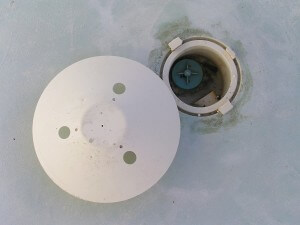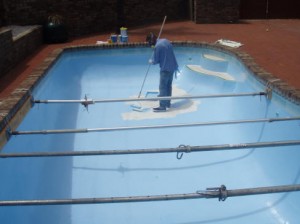Most fiberglass pools and some concrete pools will have a hydro static valve fitted at the deepest part.

It is designed to let groundwater INTO the pool, especially when empty or nearly empty.
They are made to stabilise the water pressure under the pool and to avoid any damage made by a high water table that can be due to geology (flooded nearby rivers, underground streams) or heavy continuous rain.
Be aware that such pressure if not managed correctly can damage the shell of the swimming pool when its empty or near empty. More so for fiberglass pools which don’t have the mass of concrete pools. Usually a concrete pool is engineered to withstand considerable water pressure when empty, so the hydro-static valve is omitted. When the pool was built, it would have remained empty for a month or so while the concrete cured. So you can usually empty concrete pools without issues.
Fibreglass pools have much less mass and thus may buckle or even lift out of the ground, with water beneath. It does not happen often, as a matter of fact only twice in our long history, pools were pushed up. However, you never know, you could be that third one.
Some pools will have an inspection pipe near the pool which can be used to determine the groundwater level. It’s usually located in the surrounding tiled area and will have a shower waste grill on top. So check water depth with broom handle.
For fibreglass pools we advise not emptying if the water table is high, say less than 1 M deep and if between 1 – 2 M, proceed with caution. Also don’t leave a fibreglass pool empty if heavy rain is expected.
Monitor the situation by emptying the pool about 1/3 and leave overnight so as to check on any pressures, bulges or movement of the shell. If shell stays stable, empty a further 1/3, so you can release the hydro static valve. To release the valve lift off the cover plate and then pull up the mushroom shaped cap, in the sump, which should let dirty water into the pool. If seized, then try to force up with screwdriver under the lip. ALWAYS a good idea to replace when pool empty. (As they have not changed much through the years, so any pool shop would have replacements). Leave overnight and slowly continue to empty pool. The water may will keep on coming through the valve for some time, but that is the nature of it and one has to work around of it.
You may notice some springiness in the floor, though hopefully no bulges. Try not to walk on any springy areas and while preparing the pool use some plywood sheets to spread the load. Fibreglass is quite resilient, but continuous flexing is not good. Also, older fibreglass pools may be somewhat brittle with age or if of poor quality and may crack if flexed.
Bracing should be considered, if any doubt about the water pressure, and use 2 – 3 braces across the pool. (Place as soon as you can get into the pool to work) These can be Acrow props (Hire Company) or timber posts, both with a plywood panel about 600 mm (2ft) square to spread the load. They will require moving as surface preparation and resurfacing are undertaken.
Contact us for more assistance.



